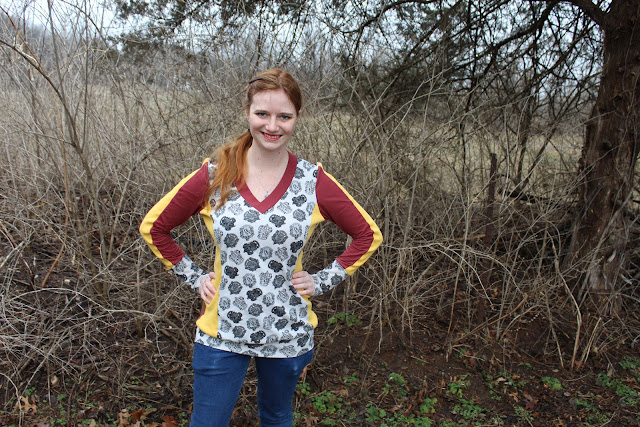It was a cotton/spandex jersey featuring the crests of all the Hogwarts houses in gray scale. Immediately, I thought this would be a neat feature fabric for a color-blocked top. I just needed to figure out the right color-blocked design.
Picking the design proved to be harder than I expected! I looked online for inspiration, but nothing seemed just right. The project took a back burner while I sewed for my brother's wedding, and then Christmas. I used some of the fabric for the sleeves on my sister-in-law's Christmas night shirt, but I still wasn't sure what style top I wanted to make for me using this fabric!
Then January rolled around and Winter Wear Designs released a new pattern, the Vivacious V-Neck - and it proved to be just the color blocked top pattern I was looking for! As soon as I saw it, I knew I'd found the pattern for my Hogwarts fabric, and requested it for the next blog tour!
This month it's the "Sew Yourself Some Love" blog tour, all about taking time to make yourself something fun! I decided my color-blocked Hogwarts shirt idea fit perfectly with this theme - it's definitely something fun I've been wanting to make myself for a while now.
As my Hogwarts house is Gryffindor, I chose red and gold for my accent colors. The red is a cotton/spandex jersey (left over from my sister-in-law's night shirt, bought at Wal-Mart a couple years ago) and the yellow/gold is a cotton rib-knit given to me by a friend who was de-stashing.
The Vivacious V-neck offers a ton of different design choices. Solid front or color blocked front? color-blocked sleeves or solid sleeves? Fancy thumb-hole cuffs, regular cuffs, or no cuffs? Bottom band or hem? Narrow neckband, wide neckband, shawl collar, or hood? I'm really excited out all the different neckline finishing options! How often do you come across a hooded V-neck pattern?
For my top I picked all the color blocking, regular cuffs, a banded hem, and the wide neck band. I really like the look of wide neck bands on V-necks! (I've hacked patterns to have similar necklines in the past, so it's exciting that this neckline treatment is actually included in this pattern. No hacking required!)
With the gold stripes down the outside of the sleeves and the faded red color I picked, I feel like this shirt has a bit of a "Vintage Quidditch Jersey" look to it. I generally avoid anything "sportsy", but hey, I'll embrace it this time! (Magical sports are different in that way.)
After I cut out my shirt, I took stock of how much house crest fabric I had left and decided to make my sister a Vivacious V-neck as well. Some things are just better if you have someone to share them with, and shirts celebrating your place in a fictional school are one of them.
As my sister is a Slytherin according to Pottermore, I pulled out the green and black cotton/spandex jerseys from my stash. (Yes, Slytherin colors are green and silver, not black, but my fabric stash seems to be a bit short of gray/silver knits at the moment, so black it had to be.)
For my sister's shirt I opted for all the color blocking, just like mine, along with the kangaroo pocket and hood. My sister is a fan of hoods, and I was excited to try out this hood specifically drafted for a V-neck.
I really like how this hood fits into the neckline and how it looks on the finished garment. I think I'll be transplanting it onto other V-neck patterns in the future!
I made my sister's shirt without telling her anything about it, so she was pretty surprised and thrilled when I gave her the finished garment.
She and I have about the same measurements now, so making her clothes is easier than ever. Whatever size I make for me, I also make for her. However much width I have to add to shoulders for me, she also requires it. When I was a teenager almost all of my tops were too tight in the shoulders so nothing fit right. I'm glad I now know how to adjust patterns for wide shoulders so my sister can avoid the same experience!
Last year my sister whittled wands for all of us siblings, and these wands seemed the perfect thing to photograph our new shirts with.
Who will win? Gryffindor or Slytherin?
Courage or Ambition?
In the end, I think sisterly love takes the day!
Meanwhile, not even magic can make an energetic dog sit still for pictures.
Oh well, we tried.
It's almost magic the way color blocking can make 1 yard of awesome fabric stretch for multiple different garments!
So far I've used this 1 yard of fabric for 3 different garments, and I still have a bit left - which I definitely have plans for! Thanks Suzanne for coming up with such a magical color blocked pattern!
I received this pattern free of charge in exchange for blogging about it, but all thoughts and opinions are my own
Sew Yourself Some Love Blog Tour
2/24
Suzanne - Winter Wear Designs Fun
2/25
Round Up - Winter Wear Designs Fun
2/26
Laura of Custom Made By Laura
2/27
Alyssa of The Sewing Goatherd
2/28
Laurie of The Bear and the Pea Atelier
Patricia of Sew Far North
Rachel of Violets and Jewels


































































